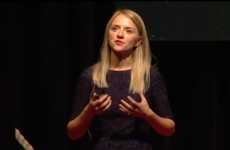
Need Inspiration?
Get inspired by 4,000+ keynote speaker videos & our founder, a top keynote speaker on innovation.
Caro Verbeek Delivers a Talk on Smell That Focuses on Art and History
Kalin Ned — March 5, 2019 — Keynote Trends
References: caroverbeek.nl & ted
Caro Verbeek is a historian, with a focus on art, who delivers a TED talk on smell. The keynote is informative and engages the audiences with opportunities for participation. The speaker delivers a quick lesson on smelling, both from a biological and a historical perspective. She also gives a few examples of art that utilize scents to bring the audience in. During her talk on smell, the art historian reveals that there is a nostril that has slow air flow, while the other has a fast one. This changes every three hours and is necessary for us to perceive odors "three-dimensionally."
Caro Verbeek shares the first instance when she was interested in becoming a "smell historian." The artwork that caught her attention was an installation by Ernesto Neto — a Brazilian contemporary artist. The experience brought up the question of whether smell can actually be a part of art and the speaker ventures into uncharted territory to explore its roots and its possible uses.
The art historian gives a few examples of instances where a piece of art, architecture, social interactions, and so on relied on smells — from the intricate structure of the Colosseum in Rome which was optimized to diffuse the smell of death to the smelly hallways of an elderly home where the scent guides the patients.
Caro Verbeek shares the first instance when she was interested in becoming a "smell historian." The artwork that caught her attention was an installation by Ernesto Neto — a Brazilian contemporary artist. The experience brought up the question of whether smell can actually be a part of art and the speaker ventures into uncharted territory to explore its roots and its possible uses.
The art historian gives a few examples of instances where a piece of art, architecture, social interactions, and so on relied on smells — from the intricate structure of the Colosseum in Rome which was optimized to diffuse the smell of death to the smelly hallways of an elderly home where the scent guides the patients.
4.6
Score
Popularity
Activity
Freshness
















